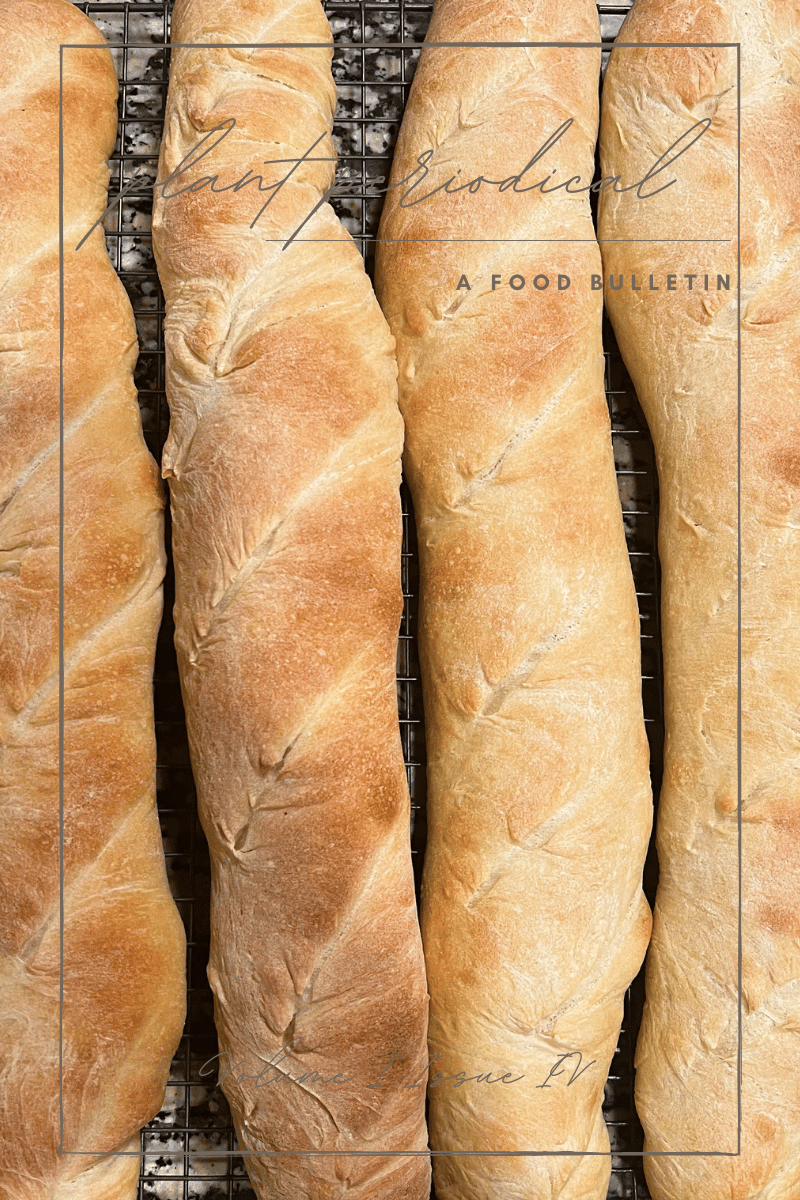- Plant Periodical
- Posts
- Baguette + Crustini
Baguette + Crustini
Classic, versatile, delicious.

Plant Periodical Volume 1 Issue 4
Intro
I bit off a bit more than I could chew with this weeks letter (pardon the delay). My original intent was to send out the one and only baguette recipe, accompanied with three dips/spreads y’all could use this holiday season. Five recipes later, I realized what I signed myself up for. I guess these are the growing pains of starting a newsletter! Anyway, today, we’ll focus on bread, next will be dips and spreads, and by Halloween we’ll be back to regular programming!
Now, the star of today’s show: bread. More specifically, a classic baguette. This is a great recipe to start your baking journey, mess around with technique, or experiment with shaping a loaf of bread. Where ever you are in your bread making journey, this recipe is a must. I learned this one the first week I was in culinary school and it’s something I make at least once a month. I love this recipe so much because of how simple it is.; no special ingredients, super versatile, and it consistently comes out tasting amazing. Also, it helped me see the similarities in all breads, regardless of ingredients, time, or outcome. This recipe gave me the know how and confidence to look at bread as a malleable, living dish, as opposed to a hard and fast set of instructions, and I hope it will do the same for you. Containing only four ingredients, learn the basics with this forgiving and always delicious baguette recipe. (Bonus: there’s a crostini recipe included, making the baguette even more versetile.)
Ingredients Explained
Baguette
Flour
I prefer to use bread flour for this recipe, but all purpose flour works just fine! Basically, don’t make an extra trip to the store just for flour. I use a variety of brands (one of my favorites being King Arthur), but if you plan on really getting into bread making, I recommend Costco’s 25 lb bag, it only costs $10! If you’re taking a more artisan route, this recipe is great for experimenting with flours made from different strains of wheat. The lack of additives will allow you to find a strain or blend that produces your favorite flavor and texture.
Water
Good old tap water will do! You just want to make sure it’s slightly above body temperature (105-110 *F), giving the yeast a comfortable environment to bloom.
Yeast
When I make a yeasted dough, I use dry active yeast. You’ll hear me say “bloom” the yeast, or add it to lukewarm water and allow the yeast to rehydrate and come back to life. On the other hand, if you’re use to using instant yeast, or that’s what you have on hand, use that instead. You won’t need to bloom the yeast, as instant yeast isn’t dehydrated and can be added directly into your dry ingredients.
Salt
Salting your dough is important because it brings it to life. Much like salted butter, it gives everything that extra umpf, no matter what ingredients you’re working with. That being said, if you’re living a low sodium life, omit. Salt doesn’t change the way the dough will rise or bake, just the flavor.
Crostini
Baguette
You don’t have to make a whole batch of baguettes to use this recipe. Crostini are a great way to elevate a store bought baguette or use day old bread.
Oil
I used olive oil, but you can use any oil. I recommend one with a flavor you enjoy (maybe avocado or walnut).
Salt
Again, I love salt and I think it only makes things better, but if it’s not for you, use lees or omit completely.
Notes Before Cooking
Baguette
Servings: 4 loaves
Prep Time: 2-3.5 hours
Cook Time: 15-30 minutes
Total Time: 2.25 - 4 hours
Crostini
Servings: 24 pieces
Prep Time: 5-10 minutes
Cook Time: 5-10 minutes
Total Time: 10-20 minutes
You can either use a stand mixer or knead by hand. If you’re new to bread making, the purpose to kneading dough is it develop gluten strands, which help give the dough it’s structure. Therefore, it’s important when kneading by hand, not to pull the dough so hard that we begin to tear it, but gently push the dough so we are elongating and stretching those strands. Also, make sure to turn your ball of dough 90 degrees every time you stretch, then fold.
Make the baguettes as close to serving time as your schedule allows, as fresh baguettes are unmatched.
Water for baguettes should be just above body temp (105-110)
Prep time for your baguettes varies so widely because rise times depend on the amount of sugar in the dough, as well as temperature of the area your dough is proofing in. I don’t think it’s ever taken me 4 hours to make baguettes, but it’s better to be safe than sorry, especially if it’s your first time taking on this project.
Ideally, you want to place your dough in a warm area (high 70’s to low 80’s). Solid spots are your porch on a summer day, in front of a sunny window, the laundry room when the dryer is on, or preheat your as low as possible, let it warm up, then turn it off and place the bowl in the oven.
Remember to use your senses. This recipe is malleable in a few ways:
You may need to adjust the amount of water you use by a few tablespoons based on your climate (ex. If it’s raining, the ambient moisture is higher than a dry, sunny day).
If you’re short on time and want to speed up the yeast bloom and rising process, add a sugar source to your blooming yeast (a tablespoon will do!!) or replace water with your milk of choice (this is called an enriched dough). These small additions increase the food source for the yeast, giving it the recourses to produce more carbon dioxide, and in turn rising faster.
Salt can be omitted, if it fits your dietary needs better. It’s in this recipe purely for flavor.
For a visual on how to shape a baguette, check out the video:
@plantperiodical23 Shaping a Baguette
Recipe
IngredientsBaguette
Crostini
| DirectionsBaguette
Crostini
|
Recipe Card


N.
